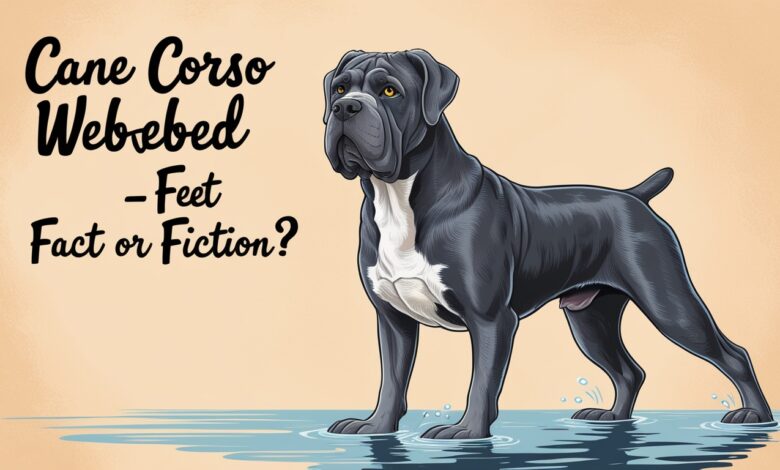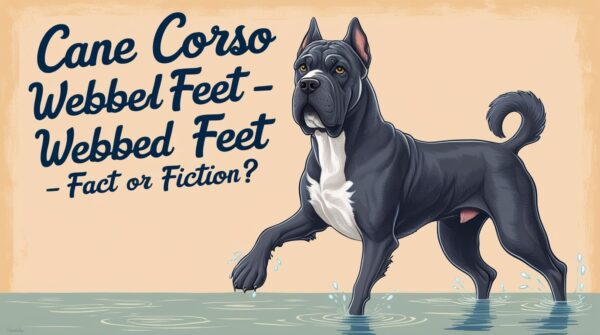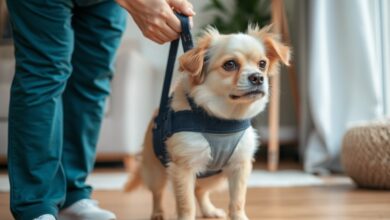Cane Corso Webbed Feet – Fact or Fiction?

Many dog owners and enthusiasts wonder if Cane Corsos possess webbed feet. This curiosity stems from their robust physique and history as working dogs. In this blog post, you will learn the truth behind this intriguing notion, exploring the genetics of Cane Corsos, their physical characteristics, and how these features influence their abilities in water and land. By delving into the facts, you can gain a clearer understanding of the breed and make informed decisions about their care and training.
Key Takeaways:
- Cane Corso do not have webbed feet: Contrary to some beliefs, Cane Corsos are not bred with webbed feet, which is a characteristic found in certain water breeds.
- Physical traits vary by breed: While Cane Corsos have strong and muscular builds, their feet are not designed for swimming like those of dogs specifically bred for that purpose.
- Myths can mislead: It’s important to differentiate between facts and myths when it comes to breed characteristics to ensure proper care and understanding of the breed.

Understanding the Cane Corso
The Cane Corso is a powerful and majestic breed, known for its loyalty and protective nature. As a member of the mastiff family, these dogs exhibit a strong build and confident demeanor, making them excellent guardians for your home. If you’re considering welcoming a Cane Corso into your family, understanding their characteristics and behavior is important to ensure a harmonious relationship.
History and Origin
One of the oldest breeds in Italy, the Cane Corso descends from the Roman war dogs, known as “Canis Pugnax.” Historically used for hunting and guarding livestock, they have a rich heritage that showcases their strength, intelligence, and unwavering loyalty to their human companions.
Physical Characteristics
Corso dogs are known for their impressive physical stature, exuding strength and elegance. Standing between 24 to 28 inches tall and weighing 90 to 120 pounds, your Cane Corso will likely have a muscular build, broad head, and a short coat that comes in various colors. Their powerful jaws and strong neck contribute to their natural guarding instincts, making them both a striking and formidable presence.
Cane Corsos are characterized by their muscular build and strong, broad head, which gives them a distinctive and commanding appearance. Their short coat requires minimal grooming, making maintenance easier for you. Additionally, they have a deep chest and a well-defined muzzle, which enhances their strength and endurance. Although they can appear intimidating, their gentle nature and affectionate temperament towards family members make them excellent companions when properly trained and socialized.

The Anatomy of Webbed Feet
Some dog breeds possess webbed feet, a distinctive feature that may prompt you to ask, Do cane corsos have webbed feet? While Cane Corsos are not typically recognized for this trait, understanding the anatomy of webbed feet can reveal the functional advantages it provides for certain breeds, enhancing their swimming capabilities and overall agility.
Definition and Function
One major characteristic of webbed feet is the presence of skin or membranes that connect the toes, making them look slightly swollen. This adaptation serves a practical purpose by allowing your dog to swim more efficiently, acting like paddles that facilitate movement through water.
Common Breeds with Webbed Feet
For those interested in dog breeds with webbed feet, several stand out, including the Labrador Retriever, Newfoundland, and Portuguese Water Dog. These breeds often engage in activities that require strong swimming abilities, aided by their unique foot structure.
Webbed feet are a significant evolutionary adaptation for certain breeds, granting them enhanced swimming efficiency and control. This feature helps with activities such as retrieving in water or assisting humans in water rescues. Familiarizing yourself with these traits can aid in better caring for your dog, especially if they share similar attributes or you plan to involve them in aquatic activities.
Cane Corso and Webbing Debate
After exploring various sources and factors, the debate regarding whether Cane Corsos possess webbed feet continues. According to Cane Corso Dog Personality Traits & Facts, enthusiasts and owners have their own opinions, igniting discussions about the breed’s physical traits and abilities.
Claims Supporting Webbed Feet
For some dog owners, the structure of the Cane Corso’s paws suggests a level of webbing that could aid in swimming and agility. Certain individuals notice that the webbing appears between the toes, giving them an advantage when traversing different terrains or engaging in water activities.
Counterarguments Against Webbed Feet
The primary argument against the existence of webbed feet in Cane Corsos is the lack of genetic evidence supporting this trait. Many breed enthusiasts assert that any apparent webbing could simply be the result of loose skin or the natural conformation of the paws, rather than a distinct feature.
It’s crucial to understand that while some owners may observe webbing, this should not be considered a definitive trait of the Cane Corso breed. Your dog’s paw structure varies significantly based on genetics and environment, so relying on anecdotal evidence could lead to misconceptions. It’s imperative to focus on your Cane Corso’s unique abilities and characteristics rather than getting caught up in unverified claims.

Benefits of Webbed Feet in Dogs
Many dog breeds, including the Cane Corso, exhibit webbed feet that offer various advantages. These adaptations can enhance their ability to swim, provide stability on diverse terrains, and improve overall physical performance. Whether your dog is engaging in water activities or navigating through challenging environments, webbed feet can play a vital role in their daily activities and well-being.
Swimming and Water Activities
Webbed feet significantly enhance a dog’s swimming capabilities. If your Cane Corso enjoys water, those webbing connections between the toes act as natural paddles, allowing them to swim effortlessly and with increased propulsion. This adaptation not only makes swimming more efficient but also helps maintain your dog’s endurance during fun-filled water play.
Impact on Movement and Agility
Impact of webbed feet in dogs can be seen in their movement and overall agility. With this unique feature, your dog can benefit from improved traction and stability, especially on slippery surfaces. This can be particularly advantageous during activities like running, hiking, or playing in muddy conditions.
Benefits of webbed feet extend beyond mere aesthetics, as they foster enhanced grip and agility. Webbing provides greater traction on various surfaces, allowing your Cane Corso to navigate tighter turns and prevent slips. This feature is especially crucial during physical activities where quick movements are required. Furthermore, as webbed feet can assist in maintaining balance, your dog may develop better coordination in their daily pursuits, contributing positively to their overall health and athleticism.
Canine Foot Structure Variability
Unlike some dog breeds that have standardized foot structures, the canine foot can exhibit a range of variabilities. These differences often arise from breeding, intended function, and genetic predisposition. Understanding these variations can help you appreciate how your dog’s foot structure may serve its unique purpose, whether for agility, strength, or endurance.
Genetic Factors
Genetic influences play a crucial role in the foot structure of dogs. Specific breeding practices can result in diverse foot shapes, sizes, and functionalities among breeds. Factors to consider include:
- Inherited traits from lineage
- Variability in muscle and bone structure
- Adaptation to specific environments
After considering these elements, you’ll better understand how genetics shape your Cane Corso’s feet.
Environmental Influences
With the right conditions, the environment can also significantly impact your dog’s foot structure. External factors, such as terrain and weather conditions, can either wear down or strengthen your dog’s paws over time.
For instance, if your Cane Corso frequently walks on hard surfaces or engages in activities that require extensive use of its paws, you may notice an increase in callusing and potential changes in foot shape. Moreover, exposure to wet or sandy environments can affect paw health and resilience. Understanding these influences helps you ensure your dog’s paws remain healthy and well-adapted to their surroundings.
Expert Opinions and Perspectives
Despite the ongoing debate about whether Cane Corsos possess webbed feet, experts in the field provide a range of insights. Veterinary professionals and breeders often emphasize the breed’s physical attributes and intended purpose, focusing on functionality rather than anecdotal evidence. Understanding their perspectives can help you make an informed decision regarding your Cane Corso’s needs.
Veterinarian Insights
Insights into Cane Corso anatomy reveal that while they may have slightly more webbing between their toes than some breeds, this trait is not significant enough to classify them as having true webbed feet. Veterinarians highlight that this minor webbing serves a practical purpose, offering additional support and grip, which is beneficial for these powerful dogs during activities.
Breeder Views
Veterinarian discussions often align with breeders who focus on the Cane Corso’s capabilities, suggesting that while they may not have identifiable webbed feet, physical strength and agile movement are inherent traits of the breed. Breeders note that their dogs’ functionality in working roles, such as guarding and protection, is more critical than any superficial traits suggested by webbing.
Expert opinions from breeders indicate that any perceived webbing does not affect health or performance. They assert that genetics play a vital role in the structure of your Cane Corso’s feet, and while many dogs have some degree of digital webbing, it does not differentiate them within the breed. Emphasizing a proper diet, exercise, and care will ensure your Cane Corso thrives, regardless of anatomical variations.
Summing up
With these considerations, you can conclude that the notion of Cane Corso dogs having webbed feet is indeed more fiction than fact. While they are strong swimmers thanks to their muscular build, their feet do not exhibit webbing like some other breeds known for that trait. Understanding your Cane Corso’s physical characteristics can help you make better care and exercise choices. For more insights, check out these Facts About the Cane Corso That You May Not Know to deepen your knowledge of this remarkable breed.
FAQ
Q: Do Cane Corsos actually have webbed feet?
A: Cane Corsos do not have webbed feet in the same sense that some other breeds, like Labrador Retrievers, do. While they do possess slightly webbed toes, this is a common trait among many dog breeds and is not unique to Cane Corsos. The webbing can provide some additional surface area for swimming and stability, but it is not pronounced or specifically bred for in Cane Corsos.
Q: What is the purpose of webbing in a dog’s feet?
A: The webbing between a dog’s toes can aid in various activities. For breeds developed for water work, such as retrieving and swimming, webbed feet can help them paddle more efficiently. In general, webbing provides a slight advantage in traction and stability, but it is not a defining characteristic for breeds like the Cane Corso, which were bred primarily for guarding and protection rather than aquatic capabilities.
Q: Should potential Cane Corso owners be concerned about webbed feet?
A: Potential Cane Corso owners need not be concerned about the presence of webbed feet in this breed. The slight webbing is a natural characteristic that contributes minimally to their performance and activity levels. The focus for prospective owners should be on training, socialization, and providing a proper diet and exercise rather than on anatomical traits like webbed feet, which have little impact on their overall health or behavior.





